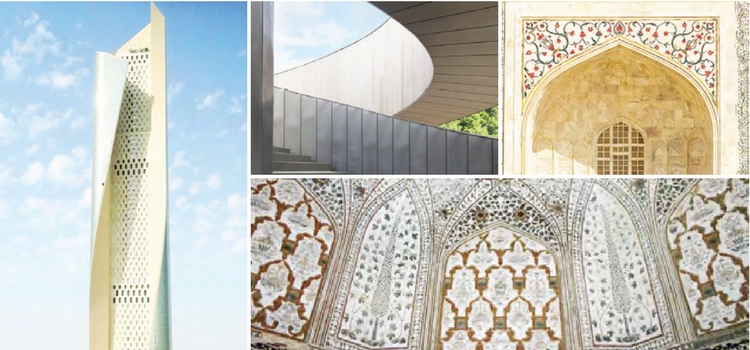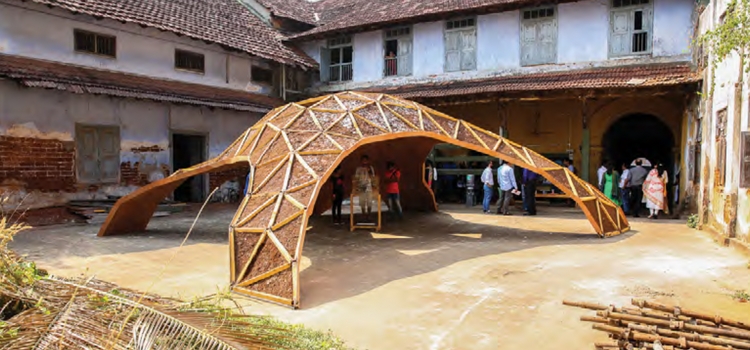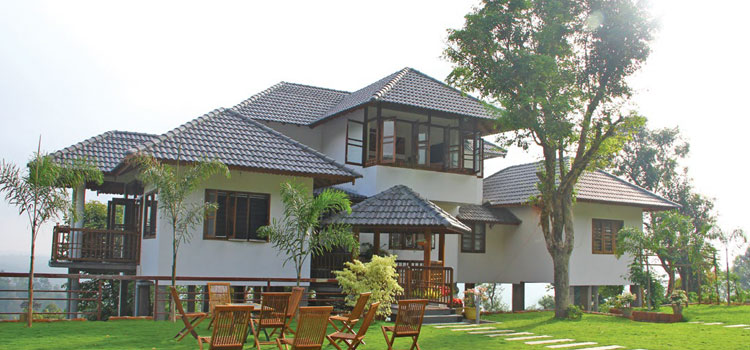Architecture
Office space designs? We only know a couple!

Text: Aatira L Zacharias & Bhyrav Gowda Images: Gareth Hoover
As soon as 1LEAPINGFROG was born, the clichés ended. We soon realised, as in life and love, the practice of architecture as a couple is riddled by complexities of the mind, heart and the ego. In all these endeavours, we must take great risks if we are to fall and remain in love with each other and our work. At times the risk can seem too great, almost insurmountable, but the joy of overcoming them only fortifies our bond.
On our very first project, our own home, we were caught in the strange situations that deign decisions and site throw at you. Only this time we dealt with them collectively. Theoretically that should be easier… not at all. It was anything but that. As our collective ideas, experience or the lack of, and insecurities collided, it became abundantly clear that the dynamics of a personal relationship and a professional one are very different. By the time we finished our home, we had more heated debates, negotiations, decisions, internal turmoil and doubts than life had thrown at us in our few years of togetherness –and we absolutely loved it. The outcome was a home that was truly us, a space that encompassed our desires and demons, our joys and despair. The young frog had grown through leaps and bounds. We were so much more aware of each other, so much more sensitive. As the line between the personal and professional blurred we learnt to respect each others’ creative territory.
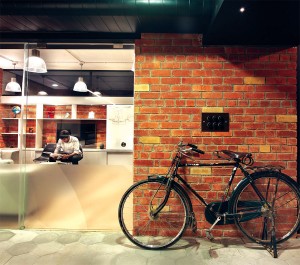 ‘Space’ remains a magical notion for us. We try to treat it without bias, giving each idea a chance to evolve into something larger than who we are. We bring to each project our collective consciousness – poetry, music, food, movies, art, travel, love, loss, memories, friendships and life itself. These have been our inspirations, especially in those moments of turmoil that haunt any designer, young and old alike.
‘Space’ remains a magical notion for us. We try to treat it without bias, giving each idea a chance to evolve into something larger than who we are. We bring to each project our collective consciousness – poetry, music, food, movies, art, travel, love, loss, memories, friendships and life itself. These have been our inspirations, especially in those moments of turmoil that haunt any designer, young and old alike.
We would like to be known as people who come up with good ideas and then oversee execution to perfection, be it for a building or a city, a living room or the backyard, or just about anything. That is after all, the underlying thread that connects us all – the seduction of a good idea!We only hope we don’t stop making mistakes, taking risks and living with doubt. In the few projects that we have finished we have tried to be brave, bold, young and most of all, honest. Of course, the burden of practice is upon us all, but we have tried to shed this weight.

Our latest project reiterates these intentions and beliefs. Our Client, CV India, was aspiring to establish a software development centre, in Bangalore. They presented us with a complex brief that had both functional and open-ended requirements to house over 30 employees involved in ideation and software development. We re-interpreted this with the intention of creating an open work culture that reinforced creativity while responding to a highly technical environment. Visualised with honest materials and exposed services, the space is intended to create an atmospheric setting that would enhance the experience of those within it, as well as their work.
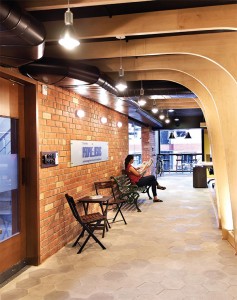 The office is set around the idea of the city in miniature . It was our deliberate attempt to create a sense of arrival while entering the space. Once across the threshold, one left Bangalore behind, entering a microcosm where various built forms such as the ‘office’, the ‘cafe’, the ‘library’ and the ‘bar’, were interspersed within an urban landscape all connected by a notional ‘street’. At the centre of it all, is the grand object, a digital portal, through which the office connects with their international team across the rest of the globe. It acts as an urban marker, visually connecting all the components around through its sculptural energy.The design process was firmly grounded as well as intuitive. We had to balance the functional aspects of the brief with the intangible. Though we enjoyed the support of an extremely liberal patron, we had to work with a conscious restraint since we didn’t want to go overboard, thereby making our ideas too literal. A deliberate attempt was made to work with varying levels of abstractness and ambiguity. With a lot of our brain-storming happening on site, the design process itself was very organic and we had to improvise as the space kept evolving in front of our eyes.Working with very passionate carpenters and contractors, the space finally achieved its atmosphere through their level of commitment and dedication. Our discourse with the client was also integral in negotiating both the brief and the site. As a rule we allow as many inputs as possible to enrich the design experience. After all, you never know where the next big idea may come from.
The office is set around the idea of the city in miniature . It was our deliberate attempt to create a sense of arrival while entering the space. Once across the threshold, one left Bangalore behind, entering a microcosm where various built forms such as the ‘office’, the ‘cafe’, the ‘library’ and the ‘bar’, were interspersed within an urban landscape all connected by a notional ‘street’. At the centre of it all, is the grand object, a digital portal, through which the office connects with their international team across the rest of the globe. It acts as an urban marker, visually connecting all the components around through its sculptural energy.The design process was firmly grounded as well as intuitive. We had to balance the functional aspects of the brief with the intangible. Though we enjoyed the support of an extremely liberal patron, we had to work with a conscious restraint since we didn’t want to go overboard, thereby making our ideas too literal. A deliberate attempt was made to work with varying levels of abstractness and ambiguity. With a lot of our brain-storming happening on site, the design process itself was very organic and we had to improvise as the space kept evolving in front of our eyes.Working with very passionate carpenters and contractors, the space finally achieved its atmosphere through their level of commitment and dedication. Our discourse with the client was also integral in negotiating both the brief and the site. As a rule we allow as many inputs as possible to enrich the design experience. After all, you never know where the next big idea may come from.
Architecture
5 Sustainable Interior Design Trends to Embrace in 2024
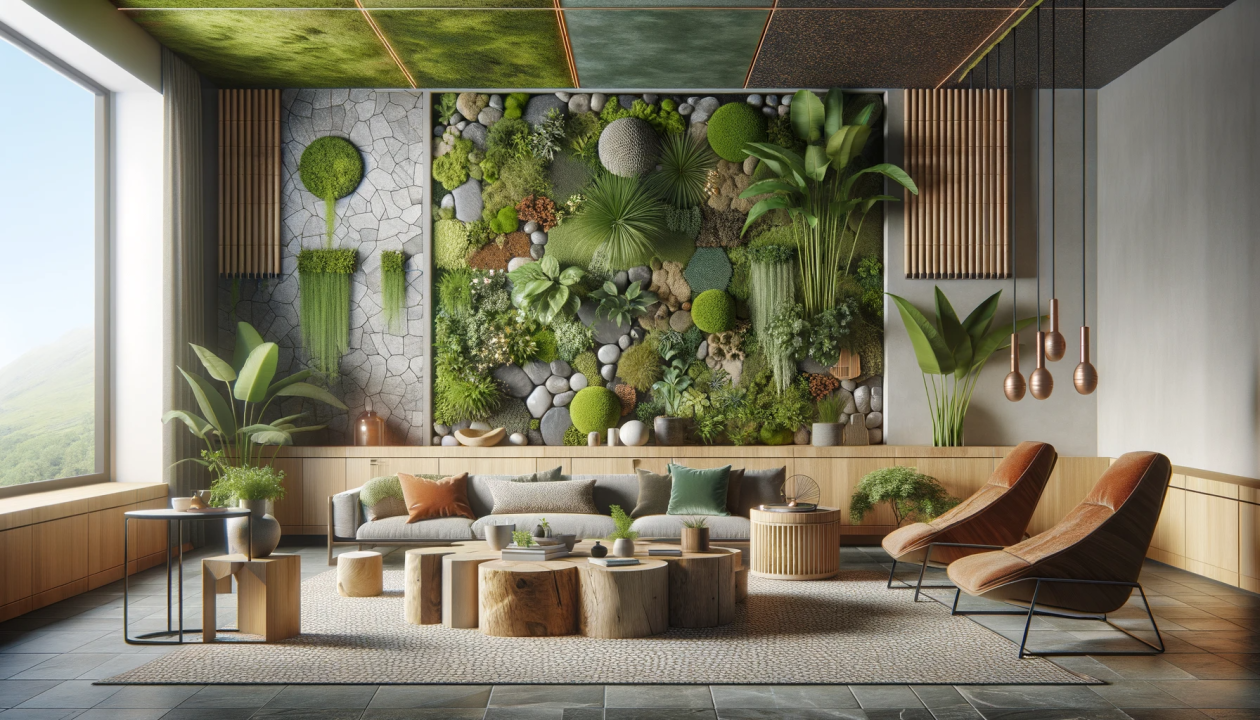
As the world becomes increasingly aware of the importance of sustainability, it’s no surprise that eco-friendly practices are making their way into the realm of interior design. In 2024, we can expect to see a surge in sustainable interior design trends that not only enhance the beauty of our living spaces but also minimise our environmental footprint. From repurposed materials to energy-efficient solutions, here are five sustainable interior design trends to embrace this year.
Upcycled Furniture:
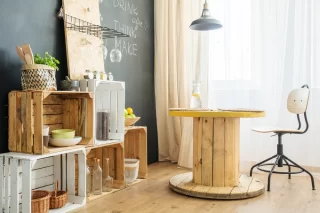
One of the most prominent sustainable interior design trends of 2024 is the use of upcycled furniture. Instead of buying new pieces, consider giving old furniture a new lease on life by refurbishing or repurposing them. From reclaimed wood tables to refurbished chairs, upcycled furniture adds character and charm to your space while reducing waste and conserving resources.
Biophilic Design:
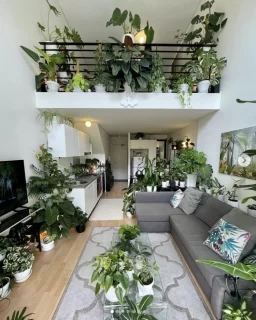
Biophilic design, which emphasizes a connection to nature, continues to gain popularity in 2024. Integrating natural elements such as plants, natural light, and organic materials into your interior design not only enhances aesthetics but also promotes well-being and sustainability. Consider incorporating living walls, indoor gardens, and sustainable wood finishes to bring the outdoors inside and create a healthier living environment.
Energy-Efficient Lighting:
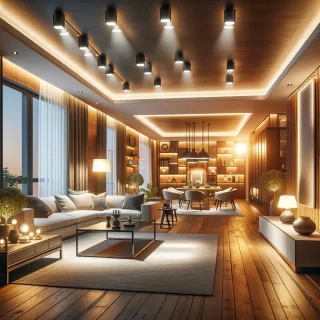
With a growing focus on energy conservation, energy-efficient lighting solutions are becoming a staple in sustainable interior design. LED lights, in particular, consume significantly less energy than traditional incandescent bulbs and last much longer, reducing both energy consumption and maintenance costs. Additionally, consider incorporating natural light sources such as skylights and large windows to maximize daylight and minimize the need for artificial lighting during the day.
Sustainable Textiles:
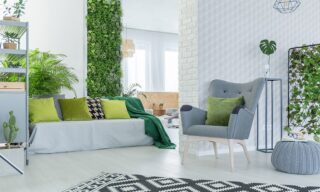
When it comes to upholstery and soft furnishings, opting for sustainable textiles is key to reducing environmental impact. Look for fabrics made from organic or recycled materials, such as organic cotton, hemp, bamboo, or recycled polyester. These materials not only reduce the use of harmful chemicals and pesticides but also minimize waste and support eco-friendly production practices. Additionally, consider investing in durable, high-quality textiles that stand the test of time, reducing the need for frequent replacements.
Smart Home Technology:
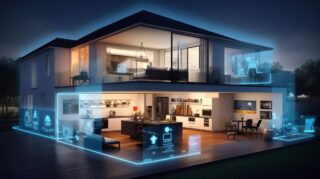
In 2024, smart home technology continues to evolve, offering innovative solutions for sustainable living. From smart thermostats that optimize energy usage to home automation systems that control lighting and appliances, these technologies can help reduce energy consumption and increase efficiency in your home. Additionally, smart home devices such as occupancy sensors and smart meters provide valuable insights into your energy usage, empowering you to make informed decisions about resource management and conservation.
As we strive to create more sustainable living environments, embracing these five interior design trends can help reduce our environmental impact while creating beautiful and functional spaces. Whether you’re upcycling old furniture, incorporating natural elements, or investing in energy-efficient technologies, every sustainable choice contributes to a greener future for generations to come. So let’s embrace these trends and make sustainability a cornerstone of our interior design practices in 2024 and beyond.
Architecture
Designing a Functional Home Office: Tips for Productivity and Comfort
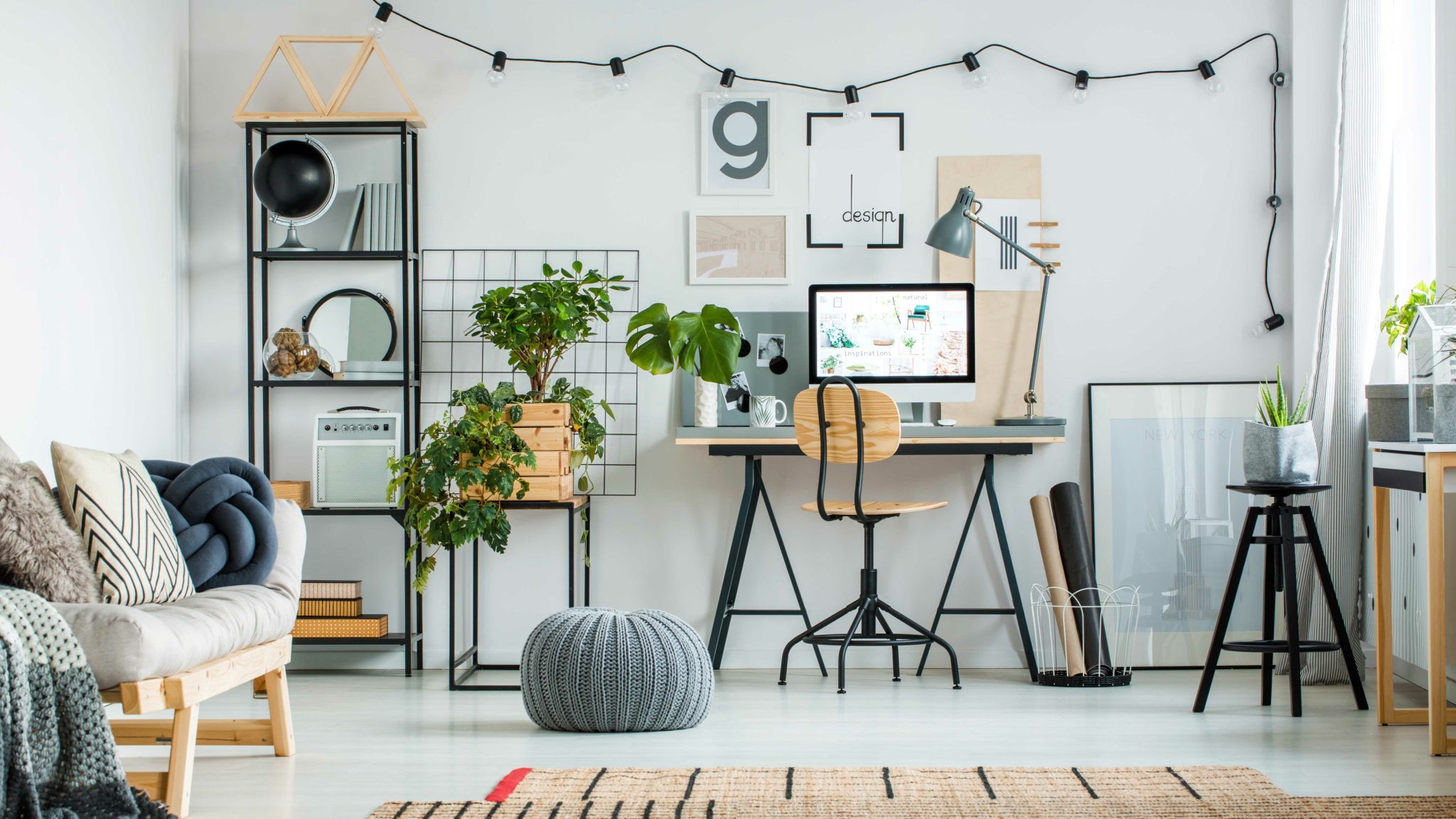
In today’s ever-evolving work landscape, the home office has become an essential sanctuary for productivity and creativity. Whether you’re a remote worker, freelancer, or entrepreneur, designing a functional home office is paramount for maintaining focus, maximizing efficiency, and enhancing overall well-being. Here are some expert tips to help you create a workspace that promotes productivity and comfort:
Choose the Right Location
Select a quiet and well-lit area in your home that is conducive to work. Ideally, this space should be away from distractions like heavy foot traffic or noise from common areas.
Invest in Ergonomic Furniture
Your office chair and desk are vital components of your workspace. Invest in ergonomic furniture that promotes good posture and reduces the risk of discomfort or injury during long hours of work.
Prioritize Natural Light
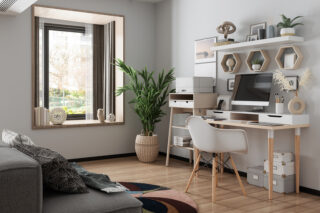
Position your desk near a window to take advantage of natural light. Natural light not only enhances mood and energy levels but also reduces eye strain and fatigue.
Declutter Regularly
Keep your workspace clutter-free by organizing cables, files, and supplies. A clean and organized environment fosters clarity of mind and helps minimize distractions.
Personalize Your Space
Incorporate elements that inspire and motivate you, such as artwork, plants, or motivational quotes. Personalizing your space can boost creativity and make your home office feel more inviting.
Optimize Technology Setup
Ensure that your technology setup including your computer, monitor, keyboard, and mouse is optimized for efficiency and comfort. Consider investing in accessories like an adjustable monitor stand or a wireless keyboard and mouse for added flexibility.
Incorporate Greenery
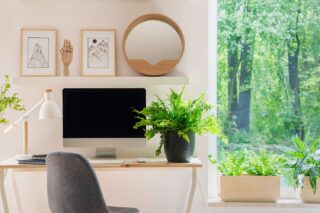
Introduce plants into your home office to improve air quality and add a touch of nature to your space. Plants not only enhance aesthetics but also have been shown to reduce stress and increase productivity.
Create a Distraction-Free Zone
Minimize distractions by setting boundaries with family members or roommates and establishing specific work hours. Consider using noise-canceling headphones or a white noise machine to block out unwanted sounds.
By implementing these tips, you can design a home office that promotes productivity, creativity, and overall well-being. Remember that every individual’s needs and preferences are unique, so feel free to experiment and adjust your workspace to suit your specific requirements. With a well-designed home office, you’ll be better equipped to tackle your tasks with focus, efficiency, and comfort.
Architecture
A Guide to Choosing the Perfect Colors for Your Home Interior

Your home is your sanctuary, and choosing the right colors for its interior can significantly impact the atmosphere and ambiance of each room. Whether you’re looking to create a cozy retreat, a vibrant living space, or a serene oasis, selecting the perfect color palette is key. In this guide, we’ll walk you through the process of choosing the right colors for your home interior to reflect your personal style and create a harmonious living environment.
Consider the Mood You Want to Create:
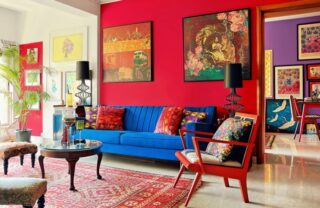
The first step in choosing the right colors for your home interior is to consider the mood or atmosphere you want to evoke in each room. Do you prefer a calming and serene space, or are you looking for something more vibrant and energizing? Think about how you want to feel when you’re in each room and choose colors that align with those emotions.
Take Lighting into Account:
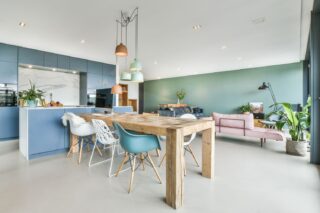
Lighting plays a crucial role in how colors appear in a room. Natural light can enhance certain hues while making others appear dull. Consider the direction and intensity of natural light in each room when choosing paint colors. Rooms with ample natural light can handle bold and vibrant colors, while those with less light may benefit from softer, lighter shades.
Create a Cohesive Color Scheme:

To ensure a cohesive flow throughout your home, choose a consistent color scheme that ties all the rooms together. You can achieve this by selecting a few key colors and using them in different combinations throughout the house. Neutral colors like whites, grays, and beiges make excellent base tones, while accent colors can add pops of personality and interest.
Explore Color Psychology:
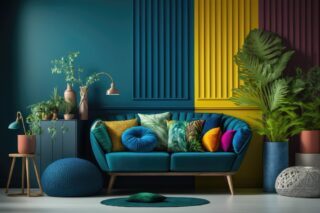
Color psychology can help you understand how different colors can affect mood and behavior. For example, blue is often associated with calmness and tranquility, making it an excellent choice for bedrooms and bathrooms. Yellow, on the other hand, can evoke feelings of happiness and energy, making it ideal for kitchens and living areas. Consider the psychological effects of each color when making your choices.
Test Paint Samples:
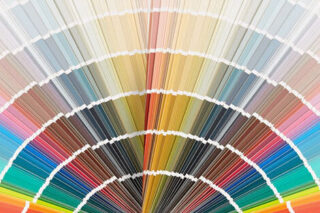
Before committing to a color for your walls, it’s essential to test paint samples in the actual space. Paint a small section of the wall with your chosen colors and observe how they look throughout the day in different lighting conditions. This will help you make an informed decision and ensure that you’re happy with the final result.
Don’t Forget About Accents and Accessories:
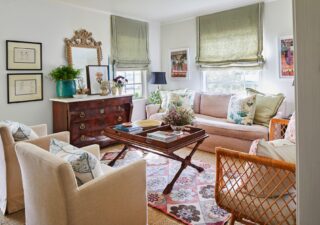
In addition to wall colors, consider how accent pieces and accessories can complement your chosen color scheme. Throw pillows, rugs, curtains, artwork, and furniture upholstery can all add depth and dimension to your space while tying the room together visually.
Choosing the right colors for your home interior is a personal and creative process that can transform your living space into a place you love to call home. By considering the mood you want to create, taking lighting into account, creating a cohesive color scheme, exploring color psychology, testing paint samples, and incorporating accents and accessories, you can design a home that reflects your unique style and personality. So, let your creativity flow, and enjoy the process of bringing your vision to life!
-

 Entertainment3 months ago
Entertainment3 months agoThe Stunning looks from Bhagya Suresh’s Wedding
-

 Fashion3 months ago
Fashion3 months agoMost Discussed Ajrakh Saree of Alia Bhatt
-

 Entertainment3 months ago
Entertainment3 months agoThe Most Stylish Guests of Bhagya Suresh Reception
-

 Entertainment4 months ago
Entertainment4 months agoEverything about the Ira Khan wedding that is out of the norm
-

 Entertainment3 months ago
Entertainment3 months agoBridal Bliss : All Bridal Looks of Swasika Vijay
-

 Entertainment3 months ago
Entertainment3 months agoAll About The Dreamy Pre Wedding Invite Of Anant Ambani & Radhika Merchant
-
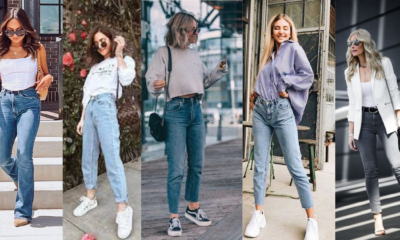
 Fashion3 months ago
Fashion3 months agoMajor Denim Trends You Need To Know in 2024
-

 Entertainment3 months ago
Entertainment3 months agoBest Looks from Golden Globes 2024


